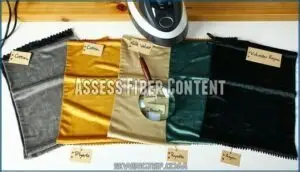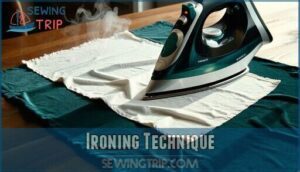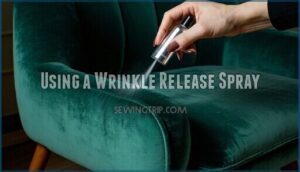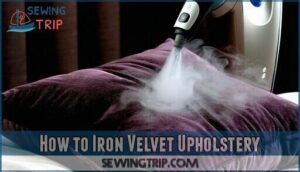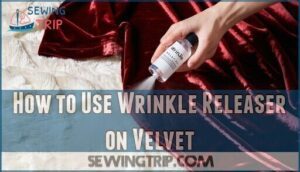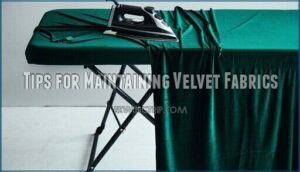This site is supported by our readers. We may earn a commission, at no cost to you, if you purchase through links.
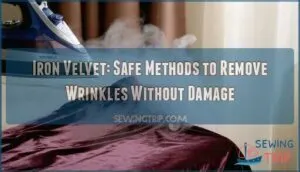
Always check your fabric label first. Place the velvet pile-side down on a plush towel, slip a thin cotton cloth between the iron and fabric, and use a low steam setting—think gentle morning fog, not blazing midday sun.
Never press hard or let the iron linger in one spot, or you’ll crush the nap and lose that signature shine. Sometimes, a steamer works better than an iron.
Wrinkle-releaser sprays are also a secret weapon. Learn the tricks of velvet care, and you’ll keep its plush perfection.
Table Of Contents
- How to Iron Velvet Fabric
- Alternatives to Ironing Velvet
- When to Dry Clean Velvet
- How to Care for Velvet Clothes
- How to Iron Velvet Upholstery
- How to Steam Velvet to Remove Wrinkles
- How to Use Wrinkle Releaser on Velvet
- How to Store Velvet Clothes and Accessories
- Tips for Maintaining Velvet Fabrics
- Frequently Asked Questions (FAQs)
- Conclusion
How to Iron Velvet Fabric
You can iron velvet fabric safely by using the right temperature settings and protecting the pile surface.
The key is working with the fabric’s grain direction and using proper support surfaces to prevent damage.
Assess Fiber Content
Before you iron velvet fabric, check the care label for fiber content.
Different materials need different heat settings and handling approaches:
- Cotton velvet – More heat-tolerant but still needs caution
- Silk velvet – Extremely delicate, requires lowest temperatures
- Rayon velvet – Moderate heat sensitivity, prone to water spots
- Polyester velvet – Most durable, handles higher heat better
- Acetate velvet – Highly heat-sensitive, easily damaged
This fiber identification determines your iron settings and cleaning methods for safe wrinkle removal.
Knowing the fiber content helps determine the fabric’s characteristics, as silk velvet offers unparalleled softness.
Test Iron Settings
Once you’ve identified your velvet’s fiber content, testing iron settings becomes your safety net against permanent damage. Never skip this step – even experienced sewers test each piece because fiber sensitivity varies dramatically between manufacturers.
Start with the lowest heat setting and hover your iron about one inch above a hidden area. This sample testing approach prevents costly mistakes on visible sections. High temperature impact can melt synthetic fibers or create permanent shine on silk velvet. To protect the fabric, consider using a muslin pressing cloth.
| Velvet Type | Safe Temperature | Steam Setting | Iron Pressure |
|---|---|---|---|
| Cotton | Medium (300°F) | Light steam | Minimal contact |
| Silk | Low (275°F) | No steam | Hover only |
| Synthetic | Low (250°F) | Light steam | Very light |
| Rayon | Very low (230°F) | No steam | Hover only |
Apply gentle iron pressure only to the fabric’s back side. If you notice any shine, flattening, or texture changes, reduce heat immediately. This damage prevention strategy saves your velvet from irreversible harm. Remember: when you iron velvet fabric successfully, you’re mastering both science and art.
Set Up Ironing Surface
Now you’re ready to create your pressing surface. A needle board works best for iron velvet fabric, but a fluffy towel provides excellent towel padding too.
This ironing surface setup prevents pile crushing while maintaining surface stability during the pressing process.
- Needle Board: Metal pins support velvet fibers, preventing flattening while you iron velvet texture
- Towel Method: Thick, fluffy towels create cushioned pressing surface with natural heat resistance
- Press Cloth: Cotton fabric layer protects velvet iron properties from direct heat contact
Ironing Technique
Most velvet fabrics respond well to gentle heat when you follow the proper iron temperature and technique.
Here’s your step-by-step approach:
- Press from the wrong side only – Place your pressing cloth over the velvet’s backside and use light, vertical motions rather than sliding the iron.
- Follow the pile direction naturally – Work with the nap’s grain using a needle board underneath to prevent crushing the texture.
- Focus on seam pressing carefully – Use steam from your iron hovering one inch above the fabric for stubborn wrinkles.
This technique protects your velvet fabric while effectively removing wrinkles through controlled ironing.
Steaming Velvet
Steam transforms wrinkled velvet fabric without crushing its delicate pile. Hold your steamer one inch above the surface, moving side-to-side for 2-3 seconds per spot.
Effortlessly smooth velvet’s wrinkles—just hover your steamer an inch above and let the gentle steam revive its plush texture.
This gentle approach relaxes fibers while preserving texture. Different velvet types respond well to steam’s moisture, making it safer than direct ironing.
Test inconspicuous areas first to avoid watermarks or pile damage.
Using a Wrinkle Release Spray
Commercial-grade wrinkle release spray offers a gentle solution for relaxing fabric wrinkles without compromising velvet’s delicate pile structure. This spray composition works by loosening fibers while maintaining fabric compatibility with even the most sensitive velvet types.
You can also explore various spray options for your velvet.
- Test fabric compatibility on a hidden seam before full application
- Hold the spray bottle 6-8 inches away from the wrinkled area
- Apply light, even mist across the affected fabric surface
- Allow 1-2 minutes drying time before handling or wearing
Professional-grade products like Downy Wrinkle Releaser work effectively on velvet fabric care needs. These alternative sprays provide excellent results when you can’t iron velvet fabric directly.
The application techniques require patience—don’t overwork the area or you’ll damage the pile. This method bridges the gap between steaming and pressing, giving you control over stubborn wrinkles while preserving velvet’s luxurious texture.
Alternatives to Ironing Velvet
When direct ironing threatens to damage velvet’s delicate pile, you’ll need gentler wrinkle-removal methods that preserve the fabric’s luxurious texture.
These alternative techniques work effectively without the risk of flattening or scorching your precious velvet pieces, using methods that are gentler.
Steaming
Professional-grade fabric steamer technology transforms wrinkled velvet into pristine elegance.
Choose steamer types with adjustable settings to prevent velvet damage while maintaining pile integrity.
Hold your iron velvet fabric tool six inches away, moving systematically across surfaces, this technique variation works brilliantly for steaming upholstery too.
DIY steaming beats traditional methods every time, with the use of adjustable settings.
Hanging Method
Gravity becomes your ally when tackling wrinkled velvet.
Hang your garment immediately after cleaning using proper hangers—wide, padded ones distribute fabric weight evenly.
Give each piece breathing room in your closet, avoiding creases through strategic spacing.
This hanging alternative works particularly well in a steamy bathroom, where moisture helps relax fibers naturally.
The storage duration depends on fabric weight and humidity levels, but most velvet pieces smooth out within hours when you iron velvet fabric using this gentle approach, which allows gravity to become your ally, and helps to relax fibers naturally, and smooth out wrinkles through strategic spacing.
Using a Clothes Steamer
A clothes steamer transforms your velvet care routine.
Choose handheld or garment steamer types for technique refinement. Hold the steamer six inches from velvet, using distilled water quality for best results.
Steam in gentle, sweeping motions without touching fabric. This fabric distance prevents pile crushing while removing wrinkles effectively.
For ideal results, consider a steamer with faster heat-up times.
Post-steam care involves hanging velvet immediately to maintain shape, using a clothes steamer and distilled water for optimal results, with gentle sweeping motions, and achieving faster heat-up times.
When to Dry Clean Velvet
Professional dry cleaning becomes essential when velvet shows stubborn stains or extensive wrinkling that home steaming can’t resolve.
You’ll want to choose this route for expensive pieces or when the care label specifically recommends professional treatment.
Spot Cleaning
When stains strike your velvet fabric, quick action saves the day. Start with stain identification – knowing whether you’re dealing with liquid spills, grease, or other substances determines your approach.
Always blot immediately with clean, white cloths rather than rubbing, which can crush velvet’s delicate pile permanently. For gentle solutions, mix mild dish soap with cool water for most stains.
Test any cleaning product on a hidden area first to prevent discoloration. The blotting technique works best when you dab from the stain’s edges inward, preventing spread.
Proper drying methods include air-drying in ventilated areas away from direct heat. These prevention tips help maintain your velvet’s luxurious appearance through careful spot cleaning and fabric care techniques.
Professional Dry Cleaning
When handling delicate velvet types, professional dry cleaning offers stain removal expertise that prevents damage to the fabric’s unique pile structure.
Expert cleaners understand dry cleaning cost varies based on garment complexity, but their specialized knowledge protects your investment.
They use fabric-safe solvents and controlled temperatures that won’t crush or melt velvet fibers.
Choosing cleaners requires research—look for establishments with velvet experience and eco-friendly practices.
Ask about their pressing methods; reputable cleaners use steam without direct contact on the pile surface.
They’ll assess whether to iron velvet or use alternative wrinkle-removal techniques.
Professional cleaning services handle challenging stains that home methods can’t tackle safely.
Their equipment maintains proper humidity levels and uses gentle agitation that preserves velvet texture.
For valuable pieces, this investment guarantees longevity while maintaining that luxurious appearance you love.
How to Care for Velvet Clothes
Proper care extends your velvet’s life and maintains its luxurious appearance between wears. You’ll need to focus on gentle handling and know when professional cleaning becomes necessary.
Velvet thrives on gentle care and mindful storage—your softest fabrics deserve a little extra attention between wears.
Handling and Storage
Smart velvet folding techniques prevent permanent creases that’ll haunt your favorite pieces.
Roll garments instead of folding to maintain that luxurious pile texture.
Proper humidity control and storage containers protect against damage while moth prevention keeps your investment safe.
- Use breathable garment bags with acid-free tissue paper for long-term storage
- Store in cool, dry spaces away from direct sunlight to prevent fading
- Roll heavier velvet items around padded tubes to avoid pressure marks
These fabric care tips guarantee your velvet fabric stays pristine.
When you iron velvet later, proper fabric storage methods make the process much easier and more effective.
Professional Cleaning
Professional cleaning keeps your velvet looking sharp without the guesswork.
Expert dry cleaners use specialized techniques and eco-friendly solvents that protect delicate fibers while removing stubborn stains.
They know which steaming methods work best for different velvet types.
Professional expertise costs more upfront, but it prevents costly damage from DIY mistakes.
Schedule cleaning every 12-18 months for ideal velvet restoration.
To keep velvet pristine, consider how fiber content affects cleaning and the importance of professional expertise for delicate fibers.
How to Iron Velvet Upholstery
Velvet upholstery requires extra care when removing wrinkles, but you can safely iron it with the right approach.
Start by checking the fabric content and testing your iron settings to avoid damaging the delicate pile surface, and then proceed with caution to ensure the best results for your velvet upholstery.
Assessing Fabric Content
When evaluating velvet upholstery for iron velvet care, you’ll need to identify the fiber content since different materials require specific ironing approaches.
Check the care label first – it reveals the material composition and recommended cleaning methods. Cotton velvet handles moderate heat better than silk or rayon varieties, which demand lower temperatures. Synthetic velvets like polyester offer more heat tolerance.
If no label exists, perform burn testing on a hidden sample or examine the fabric’s texture and sheen.
- Cotton velvet: Breathable and forgiving, tolerates gentle heat
- Silk velvet: Luxurious but delicate, requires minimal temperature
- Synthetic blends: Durable and heat-resistant, ideal for beginners
Test an inconspicuous area first, starting with lower heat settings without steam, then adjust based on the fabric’s reaction to prevent pile damage.
Testing Iron Settings
Three critical steps protect your velvet upholstery during iron settings testing.
Start with the lowest heat setting—synthetic velvet melts easily, while natural fibers tolerate more heat.
Test on a hidden area first, checking for fabric damage after each temperature adjustment.
Monitor how different iron settings affect the pile structure.
| Heat Setting | Fiber Type | Temperature Range | Risk Level |
|---|---|---|---|
| Low (1-2) | Synthetic/Acetate | 200-250°F | Minimal |
| Medium (3-4) | Cotton/Linen | 300-350°F | Moderate |
| High (5-6) | Natural Silk | 400-450°F | High |
| Steam Only | All Types | Variable | Low |
Proper sample testing prevents costly mistakes—damaged velvet can’t be reversed once the pile flattens or melts.
Preparing The Upholstery
Begin vacuuming first to remove surface dirt and debris from your velvet upholstery. Select a soft brush attachment to avoid damaging the delicate pile during cleaning.
Apply stain pre-treatment solutions carefully to any visible spots before ironing. Protect adjacent surfaces with clean towels or drop cloths.
Always test your iron settings on a hidden area first, ensuring the steam and fabric temperature won’t harm the upholstery’s texture. To protect the delicate pile, assess velvet fiber content before ironing, using soft brush attachment and delicate pile consideration to avoid damage, and remembering to test your iron and protect adjacent surfaces.
How to Steam Velvet to Remove Wrinkles
Steaming stands as the safest method for removing wrinkles from velvet without risking damage to its delicate pile.
You’ll need the right steamer and technique to restore your velvet’s smooth appearance while preserving its luxurious texture, and to ensure the best results, it’s crucial to follow the proper method.
Choosing a Steamer
When shopping for a garment steamer to iron velvet safely, you’ll want to keep in mind several key factors.
Different steamer types offer varying benefits for delicate fabrics like velvet.
Consider these essential features:
- Water capacity – Look for models with at least 15-20 minutes of continuous steam time
- Steam settings – Adjustable temperature controls prevent pile damage and heat marks
- Fabric compatibility – Choose steamers designed for delicate materials with anti-drip features
- Nozzle design – Ergonomic steam heads provide better control for vertical steaming
Portable steamer models from brands like Conair and Rowenta deliver reliable performance for home use, while their compact design makes storage simple.
Finding the best steamer options can simplify garment care.
Steaming Technique
Master the art of steaming velvet by maintaining proper distance and technique. Hold your garment steamer approximately one inch above the velvet fabric surface to prevent pile flattening.
Move systematically across wrinkled areas using overlapping passes for thorough coverage.
| Steamer Types | Steaming Distance | Fabric Support |
|---|---|---|
| Handheld units | 1 inch minimum | Needle board recommended |
| Standing models | 1-2 inches | Padded surface ideal |
| Iron steamers | 0.5-1 inch | Pressing cloth optional |
| Professional grade | 1.5 inches | Velvet board preferred |
| Travel steamers | 0.75 inch | Towel backing works |
Work methodically with gentle, sweeping motions rather than pressing directly onto the velvet fabric. This prevents water saturation while allowing steam to penetrate and relax fibers.
For double-sided velvet, steam one side completely before flipping. Always inspect the nap afterward to confirm you haven’t damaged the pile structure during the steaming process.
Preparing The Velvet
Now you’re ready to prep your velvet for steaming success.
Start with fiber identification to determine heat tolerance, then surface cleaning removes debris that could embed during steaming.
Check your wrinkle assessment and tool selection – handheld steamers work best for delicate pile preservation through safe handling techniques.
- Protect your investment – proper prep prevents costly velvet damage
- Feel confident – knowing your fabric type eliminates guesswork stress
- Achieve perfection – clean, assessed velvet steams beautifully every time
How to Use Wrinkle Releaser on Velvet
When traditional ironing feels too risky for your precious velvet pieces, wrinkle releaser spray offers a gentler alternative that loosens fibers without direct heat contact.
This liquid solution works by relaxing the fabric’s structure, making it easier to smooth out creases with minimal handling, utilizing a gentler approach to fabric care.
Choosing a Wrinkle Releaser
When selecting a wrinkle releaser for velvet fabric, fabric compatibility tops your priority list.
Water-based formulas work best since they won’t leave residue on delicate fibers.
Check ingredient lists—avoid harsh chemicals that can damage velvet’s pile structure.
Consider using quality velvet sprays for ideal results.
| Factor | Best Choice | Why It Matters |
|---|---|---|
| Ingredients Matter | Plant-based, unscented | Prevents chemical damage to fibers |
| Application Techniques | Trigger spray bottles | Better control than aerosols |
| Scent Preferences | Fragrance-free options | Avoids potential fabric reactions |
Test any product on a hidden area first.
Downy and Magic Wrinkle Releaser earn high marks for velvet use, while Grove Co. specifically warns against certain fiber types.
Cost effectiveness comes from choosing products that work without requiring multiple applications.
Applying The Releaser
Applying wrinkle releaser to velvet fabric requires precision and patience to avoid damaging the delicate pile.
Hold the spray bottle 6-8 inches from the fabric surface and mist evenly across wrinkled areas.
Test fabric compatibility first on a hidden section to prevent staining.
- Light, even coverage – Apply thin layers rather than saturating the velvet fabric
- Work in sections – Focus on one area at a time for better control and steam penetration
- Maintain proper distance – Keep spray bottle consistent distance to prevent dripping or pooling
- Use releaser alternatives – Consider distilled water mixed with fabric softener as a gentler option
Removing Wrinkles
After misting the fabric, you’ll want to work the wrinkle releaser into the velvet’s pile using gentle circular motions. This reactivates the fibers without damaging the delicate nap.
Next, lightly stretch the wrinkled areas with your hands, working in the direction of the fabric’s natural grain. For stubborn wrinkles, repeat the process until the fabric smooths out completely.
| Step | Action | Result |
|---|---|---|
| Mist | Spray 6 inches away | Fibers soften |
| Work | Gentle circular motions | Pile redistributes |
| Stretch | Follow fabric grain | Wrinkles release |
This technique beats traditional ironing methods and works as an effective hanging alternative when professional cleaning isn’t needed. It provides a simple and efficient way to remove wrinkles from velvet fabrics, making it a useful technique for everyday use.
How to Store Velvet Clothes and Accessories
Proper storage protects your velvet items from wrinkles and damage, extending their lifespan substantially.
You’ll want to clean everything thoroughly before storing and use the right materials to maintain that luxurious pile texture, ensuring the velvet items remain in good condition.
Cleaning Before Storage
Clean your velvet pieces thoroughly before tucking them away for storage. This vital step prevents stains from setting and maintains fabric integrity during extended periods of non-use.
Follow these essential cleaning steps:
- Dust Removal – Use a lint roller or soft brush to eliminate surface particles
- Stain Prevention – Address any spots immediately with gentle blotting motions
- Mild Detergents – Apply diluted, fabric-safe cleaners for stubborn marks only
- Proper Drying – Allow complete air-drying before storage to prevent mold
- Storage Environment – Make certain clean, dry conditions to protect your velvet fabric
Reorganizing the structure for better readability results in the above format, where each group of related ideas is separated by double newlines for clarity.
Using Acid-Free Tissue Paper
Protect your velvet fabric with archival tissue that prevents yellowing and damage.
Quality acid-free tissue creates a barrier against dust while maintaining breathability.
Wrap each piece individually, ensuring tissue qualities meet conservation standards.
This safe storage method protects embellishments and maintains velvet’s luxurious texture.
Roll rather than fold to preserve the pile’s integrity during long-term storage, using archival tissue to prevent damage, and keep the velvet in good condition with quality acid-free tissue.
Avoiding Moisture and Humidity
Within the domain of proper velvet storage, moisture stands as your fabric’s greatest enemy.
High humidity can permanently damage delicate fibers, creating wrinkles that resist even professional treatments.
Follow these storage solutions to prevent humidity damage:
- Air Circulation: Use dehumidifiers or fans to maintain consistent airflow
- Mold Prevention: Store in breathable cotton garments bags, never plastic
- Drying Techniques: Add silica gel packets to absorb excess moisture
- Storage Solutions: Choose closets over drawers for better ventilation
Smart moisture control protects your velvet fabric investment for years.
Tips for Maintaining Velvet Fabrics
You’ll want to maintain your velvet’s luxurious texture with a few simple habits that prevent damage before it starts.
These proactive steps will keep your velvet looking fresh and extend its lifespan substantially.
Regular Brushing
Regular brushing preserves velvet’s luxurious appearance by lifting crushed fabric fibers and preventing permanent pile damage.
Use a soft brush following the nap direction to maintain texture between professional cleanings.
| Brush Types | Brushing Frequency | Technique |
|---|---|---|
| Natural bristle brush | Weekly for garments | Light, gentle strokes |
| Velvet brush | After each wear | Follow nap direction |
| Soft-bristled upholstery brush | Monthly for furniture | Circular motions |
| Lint roller alternative | As needed | Quick touch-ups |
Choose the right brush for your velvet fabric to avoid damaging the delicate pile structure.
Avoiding Friction
Through proper fabric handling, you’ll preserve velvet’s luxurious texture by minimizing friction damage.
Here’s how to protect your velvet fabric:
- Pile Direction: Always brush and iron following the natural nap direction
- Pressure Control: Apply minimal pressure when handling to prevent pile crushing
- Fabric Softness: Use gentle lifting motions rather than dragging across smooth surfaces
- Heat Reduction: Keep iron temperatures low to maintain fabric integrity
Gentle handling preserves velvet’s distinctive plush feel indefinitely.
Professional Cleaning Recommendations
Beyond regular maintenance, trusted professional dry cleaners offer specialized steam treatments that preserve velvet’s luxurious texture.
Expert consultation guarantees proper stain removal techniques, while eco-friendly solvents protect both fabric and environment.
To keep your sewing machine in top condition, remember to address common sewing problems.
Schedule cleanings every 12-18 months for best results.
| Service Type | Frequency | Cost Range | Benefits | When to Use |
|---|---|---|---|---|
| Professional Dry Cleaning | Every 12-18 months | $15-40 per item | Complete cleaning, pile preservation | Heavy soiling, "Dry Clean Only" labels |
| Steam Treatment | As needed | $10-25 per item | Wrinkle removal, texture restoration | Between cleanings, minor wrinkles |
| Spot Treatment | Immediate | $5-15 per spot | Targeted stain removal | Fresh spills, localized stains |
| Protective Coating | After cleaning | $8-20 per item | Stain resistance, extended life | High-use items, light-colored velvet |
| Expert Consultation | Before cleaning | Free-$25 | Fabric assessment, care advice | Vintage pieces, unknown fiber content |
Frequently Asked Questions (FAQs)
Can You Iron Velvet?
Did you know 80% of velvet damage comes from improper ironing?
You can iron velvet, but it’s tricky—always use steam, keep the iron hovering above, and never press directly.
Treat velvet like royalty, not a pancake.
Does Velvet melt if ironed?
Velvet can melt if you iron it with too much heat, especially if it’s made from synthetic fibers.
Always check the care label, use the lowest setting, and never press the iron directly onto the pile.
How do you Iron Velvet?
Set your iron to the lowest heat, then place velvet face down on a towel.
Hover the iron above the fabric, using steam to relax wrinkles.
Don’t press directly—think of it as giving velvet a gentle pep talk.
Why is velvet hard to iron & press?
You’ll find ironing velvet tricky because its plush pile crushes under heat and pressure, leaving shiny marks or odd patterns.
It’s like trying to smooth grass with a brick—one wrong move, and the texture’s gone.
Is velvet a good fabric?
Like a crown worn by royalty, you’ll find velvet both luxurious and practical.
It’s soft, durable, and versatile—great for clothes or décor.
Just remember, it demands gentle care, or it’ll show every wrinkle and mark.
How do you steam a velvet item?
Hold a steamer or iron about an inch above the fabric, letting the steam work its magic—no direct contact needed.
Gently smooth with your hand, following the nap. It’s like reviving a bedhead—just with velvet.
What temperature do you iron velvet at?
Think of velvet as a cat’s fur—too much heat, and it’ll never look the same.
You’ll want to iron at 300°F (148°C) or the “3” setting, always using a pressing cloth and very light pressure.
How do you unwrinkle velvet?
Steam works wonders—hang your velvet in the bathroom during a hot shower or use a handheld steamer, holding it an inch above the fabric.
Skip direct ironing; it flattens the plush pile and ruins texture.
Can I iron onto velvet?
You can iron onto velvet, but it’s a bit like walking a tightrope—one wrong move flattens the plush pile.
Always use a pressing cloth, low heat, and iron on the fabric’s reverse side for safety.
Can velvet fabric be repaired after pile damage?
Velvet pile damage is like a bad hair day—sometimes you can brush it out, sometimes not.
You can gently steam and brush the area to lift the pile, but deep damage often can’t be fully reversed.
Conclusion
Imagine using a floppy disk to save your velvet—outdated, but ironing velvet with care never is.
You’ve learned the safest ways to iron velvet, from testing settings to using steam or wrinkle releaser. Don’t rush; velvet rewards patience and gentle handling.
Always check labels, use protective layers, and avoid pressing too hard. With these tips, your velvet will stay plush, wrinkle-free, and ready for any occasion.
So, treat it right, and it’ll keep shining.

